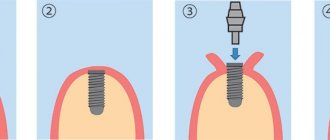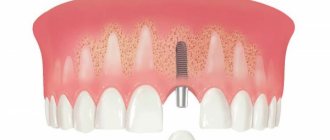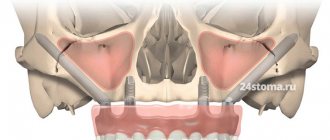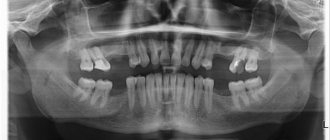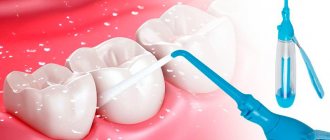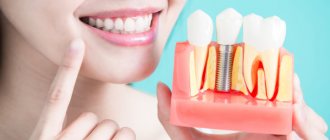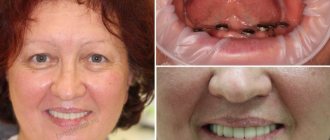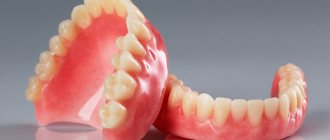Choice according to indications and budget
The best dentures are those that are indicated for the patient. Generally speaking, the most modern designs will be those based on implants. However, there are two very important points here: implantation has a number of limitations and is considered an expensive procedure (especially if we are talking about complete dental restoration). In this case, other designs come to the rescue, which are also designed to restore functionality and aesthetics. Before we start talking about the different systems in more detail, we need to make some distinctions so that you don't get confused.
All dentures are usually divided into several types. First of all, the number of teeth being replaced is taken into account: this criterion implies the installation of a partial or complete denture. According to the method of removing the structure from the oral cavity, removable and conditionally removable dentures are distinguished. Which ones are better - read on.
Which denture is best for missing teeth?
Previously, patients who, for one reason or another, were unable to have implants installed, had to put up with rather uncomfortable prostheses made of hard plastic. Today there are modern designs on the market that cause virtually no inconvenience to their owner. Many are also looking for the best removable dentures for the upper jaw, since it is when restoring teeth in the upper jaw that good fixation of the structure is especially important so that the denture does not fall out in the most unexpected cases. Installation of a high-quality fixed (conditionally removable) complete denture is not complete without implantation.
Bridge prosthesis on implants
When several teeth are missing in a row, implant-supported dentures are the ideal choice. As a rule, 2 implants are implanted, on which a prosthesis is subsequently installed, simulating the crown part of the tooth.
Classic bridges
Fixed structures that replace a fragment of the dentition and are installed on adjacent ground teeth. The most modern dental bridges are usually made of ceramic and look more aesthetically pleasing than their metal counterparts.
Butterfly prosthesis
So named because of its shape, which resembles the wings of insects. Allows you to replace several missing teeth. A plastic butterfly prosthesis imitates the crown of a tooth and part of the palate, attached to adjacent teeth using clasps. Application is justified as a temporary measure.
Clasp and plate dentures
The best dentures of this type are considered to be structures made of nylon and acrylic, imitating part of the dentition on both sides of the jaw. These are so-called laminar dentures. There are designs with metal arches (clasp dentures), which are less beneficial from the point of view of aesthetics and possible allergic reactions.
Complete denture on implants with bar fixation
It is considered the best option for a complete denture on implants, since the load is distributed most correctly and high stability of the entire structure is achieved.
Complete denture on implants with ball-shaped fixation
A spherical abutment is installed on each implanted implant, which is secured to the prosthesis using special locks. It is also considered an excellent option, but is slightly inferior to beam structures in terms of reliability.
Removable denture on mini-implants
Mini-implants are also implanted into the bone, so the volume of bone tissue is just as important here as when installing standard implants. In this case, only removable structures are suitable for prosthetics, since mini-implants are used as a temporary option and cannot bear a more serious load.
Removable complete denture
Removable complete dentures completely model the jaw and palate. Today there are many models on the market, but the most modern are acrylic and nylon prostheses of the new generation.
Orthopedic dentists in Moscow
Who is an orthopedic dentist?
An orthopedic dentist is a medical specialist who receives professional training in the field of prevention, diagnosis and treatment of dysfunction and integrity of the jaws and teeth. Treatment in Moscow is carried out using prosthetics, as well as the use of:
- regulatory devices,
- replacement devices.
What do orthopedic dentists do?
In Moscow, orthopedic dentists deal not only with pathologies of teeth or jaws, but also deal with diseases of the lips, gums, mouth, and tongue. They eliminate the consequences of trauma in the periodontal area, distributing the functional load on healthy teeth whenever possible. In addition, the scope of practice of an orthopedic dentist includes the following:
- treatment of pathology of masticatory muscles, periodontal disease, jaws;
- removal of injuries to hard tissues (pulp, teeth);
- elimination of supercontacts (balancing and hyperbalancing);
- relieving painful activity of the masticatory muscles;
- creation of stable and permanent central occlusion, elimination of its violation before the start of orthopedic treatment;
- after treatment – restoration of functional occlusion;
- disease prevention.
People are referred to orthopedic dentists in Moscow for diseases such as:
- periodontitis;
- caries;
- weakens teeth
- pulpitis;
- injuries;
- tooth erosion, etc.
What symptoms are referred to an orthopedic dentist?
The most common reason for visiting an orthopedic dentist in Moscow is the appearance of a carious cavity covered with dark dentin. The pathology manifests itself in a severe sore throat or sharp pain as a result of sour, salty, sweet things getting into the hole. It is also recommended to immediately contact an orthopedic dentist in the following situations:
- for acute night pain;
- for pain when eating or drinking;
- with constant aching pain, regardless of the time of day, aches;
- for pain when biting a diseased tooth;
- when you feel as if the tooth has grown;
- for pain in the gums, both constant and periodic;
- with edema or swelling;
- with inflammation of the gums;
- if there is bleeding during brushing your teeth and during the day;
- when a bag of pus appears on the gum, and so on.
To carry out successful treatment it is necessary to undergo a diagnosis. In Moscow, orthopedic dentists use diagnostic tools such as:
- computed tomogram,
- axiography,
- dental digital radiography,
- diagnostic models of jaws,
- TScan
- orthopantomogram - panoramic image of the jaws,
- wax modeling, etc.
Where in Moscow can you get this specialty?
Departments of dentistry and surgical orthopedics, where professional specialists - orthopedic dentists are trained to work in Moscow clinics, exist in such large universities as:
- RNIMU named after. N. I. Pirogova;
- MONIKI;
- MGMSU;
- MMA im. I. M. Sechenov;
- RMA;
- RUDN University and so on.
Famous Moscow specialists
The term "orthopedics" appeared in 1741. Andri introduced it. It was he who first named the new dental specialty. The term was made up of two Greek words - “orthos”, which means “straight”, and “paideuo” - “to form”, “to grow”.
In Russia, on the initiative of Katz, the term “prosthetic dentistry”, which existed at the beginning of the last century, was replaced in 1936 by the currently existing “orthopedic dentistry”. Under Soviet rule, the most active development of this science began. Gofung, Entin, Berkovich and many other great scientists and doctors paid special attention to it. Among the works in the field of dental orthopedics, the brilliant works of Sechenov, Botkin, Pavlov, and Bykov stand out.
Which material is better and will last longer?
The material from which the prosthesis is made has the greatest impact on wearing comfort, and this is especially true for removable systems. If no errors were made during the manufacture of the structure itself, but the prosthesis still causes significant discomfort, then the problem is most likely due to the poor quality of the material. Of course, no such system can provide 100% convenience (especially at the adaptation stage), but modern materials make it possible to achieve very high performance. So, what qualities should the best materials for dentures have:
- Hypoallergenic.
Many people are allergic to plastic and acrylic. - "Friendly" to gums.
If the denture rubs your gums too much, wearing it will be a complete pain. - Color fastness.
Immunity to staining and environmental influences. - Acceptable strength.
Despite the fact that a removable denture rarely lasts more than 5–6 years, the structure should not be overly fragile.
If we talk about specific brands of removable dentures, the best acrylic denture is considered to be Acry-Free (“Acry-Free”) made from acrylic-free plastic: it is very comfortable, does not shrink when worn, does not stain and does not cause allergies. The best nylon dentures at the moment are the Quattro Ti brand. However, “Quadrotti” has restrictions on its use: to install them, one of the jaws must have several healthy teeth, however, like other clasp-type dentures. As for non-removable systems, metal-free structures are increasingly being used, which look more aesthetically pleasing and do not cause allergies, but are also less durable.
How much do the best dentures cost?
| Construction type | Price |
| Crowns | From 12,000 rubles for metal ceramics to 40,000 for zirconium crowns |
| Veneers | 20,000 – 25,000 rubles per unit |
| Partial denture on implants | From 70,000 rubles |
| Classic bridge | On average 8,000 – 15,000 rubles |
| Complete denture on implants | 150,000 – 600,000 rubles for one jaw. Depends on the number and brand of implants implanted. |
| Butterfly prosthesis | From 4,000 rubles depending on the material |
| Plate dentures | From 20,000 rubles. 30,000 – 35,000 rubles for Quadrotti prostheses |
| Removable complete denture | On average 35,000 rubles for a full Acry Free prosthesis |
| Removable denture on mini-implants | 100,000–120,000 rubles for one jaw |
Publisher: Expert magazine about dentistry Startsmile.ru
Dental implants or dental implants customer reviews
Dental implants reviews - it’s clear why such a request is of interest to the patient. After all, health and well-being depend on quality treatment. We invite you to read people's responses. So, dental implant reviews:
“I am glad that I chose implantation. My new tooth looks and, most importantly, feels completely natural. In addition, I decided to do whitening at the same time and now I just can’t stop smiling! It’s not just me who likes her so much.”
Olesya 20 years old
“I expected that healing after implantation would be long and not the most pleasant period in my life. Words cannot express how glad I am that I was wrong! I didn't have to change my plans and I was able to go on vacation with my family without worrying about my new tooth. I haven’t rested so well for a long time!”
Victor 37 years old
After losing one tooth, I didn’t want to put up a dental bridge or grind down the good neighboring teeth, because I was young and this prospect didn’t make me happy. I decided to get a dental implant. Now my new tooth is like my own. The surgeon performed the operation so quickly that I didn’t even have time to blink an eye (I was just worrying in vain), and the implant took root without problems, the doctor monitored the healing process periodically, and then they took an impression of me and put a crown on the implant. No discomfort, and that's important. I am very, very pleased!!!
Tatyana 28 years old
What allows you to achieve such a wonderful effect with dental implants?
During the installation of the implant, to create a safety margin, a titanium rod is used as a root, onto which an implant created specifically for you is attached on top. The materials used for implantation are environmentally friendly and safe when used in combination with biological tissues, which explains the 100% engraftment rate. The tooth created in this way will function and look absolutely natural, and can also serve as a support when using other prosthetic methods. If you are not satisfied with the natural appearance of your teeth, an implant may motivate you to install veneers, whiten your teeth, or straighten your teeth.
Another undeniable advantage is that the implant protects bone tissue from atrophy at the site of tooth loss, and, consequently, from jaw deformation.
Indications for implantation may include:
- single dental defects;
- included defects;
- end defects;
- complete absence of teeth.
Types and stages of dental implantation
Currently, there are two main methods for implantation:
One-stage implantation
One-stage dental implantation technology involves the installation of non-removable implants. A special bone bed is formed, onto which an implant is subsequently installed, with a support head protruding into the oral cavity. Prosthetics are performed a few days after the operation. Many people have done dental implants in a similar way. Reviews indicate the effectiveness of this method.
Two-stage dental implantation
Two-stage dental implantation differs in that first the internal element (the root part of the dental implant) is installed in the bone bed on the jaw, then the gingival cuff former is placed, sutures are applied to the mucous membrane, and the prosthesis is placed depending on the location after several months (two to three months in case of installation on the lower jaw, four to six – on the upper jaw).
Implantation can also be immediate or delayed. A technique such as direct dental implantation is characterized by the installation of an implant immediately after tooth extraction. The dimensions of the alveolar socket and the dental implant are not identical, and most often this technology is used when implanting teeth in two stages, because During it, the root part of the dental implant is installed for engraftment.
Unlike immediate dental implantation, delayed dental implantation involves placing a dental implant in the bone bed after a sufficiently long time (up to nine months) after tooth extraction, so that the bone tissue has time to rebuild.
Express dental implantation
Express dental implantation is a low-traumatic technology with which you can regain a confident, wide smile in just a few visits to the clinic! What are the differences between the express implantation method and the advantages over conventional dental implantation?
When using the traditional technique, it is necessary to make an incision in the gum, apply sutures after installing the implant, then, after three to six months, open the gum again, install a gum adapter, then an abutment and an implant crown. Express dental implantation does not require cutting the gums and placing sutures at the implant installation site - it is inserted transgingivally (through a puncture in the gum), a gingival adapter and a temporary crown are placed, this is very convenient for the patient, since immediately after the procedure you can eat without experiencing pain and discomfort. The whole procedure takes no more than fifteen minutes. Express dental implantation allows you to avoid pain after implant installation and provides aesthetic benefits. After four months, a permanent crown is installed on the dental implant.
!!!
Express dental implantation requires the highest professionalism of dentists and the availability of modern technology. When choosing an implantation method, it is necessary to take into account that with express implantation there is a risk of implant rejection, and this method may not be indicated for all patients. Therefore, before implantation, it is necessary to discuss all the nuances of the operation with your doctor. Attention, you should not agree to the operation if the cost of implantation is suspiciously low or you are promised large discounts. As a rule, the outcome of the operation will not be what you expect, and retreatment will cost several times more. It will also be useful to familiarize yourself with the results of the query “dental implantation reviews,” since experienced specialists have an extensive portfolio.
Dental implants are presented in dentistry in several dozen varieties. The most common are root-shaped dental implants, which during the process of osseointegration (fusion with the jaw bone) take on the functions of a natural root; they are screw, plate or cylindrical. Screw and cylindrical dental implants are preferable if the thickness of the jaw bone tissue is sufficient, otherwise blood circulation in the jaw may be impaired. If the bone tissue is not massive enough, plate dental implants are used. The special flattened shape of such an implant makes it possible to implant teeth in elderly people or install a dental implant in cases where the volume of bone tissue has decreased due to the fact that the tooth was removed long ago.
In case of significant atrophic changes in the jaw bone tissue, subperiosteal implants are used, which are inserted under the periosteum. Endodontic dental implants make it possible to secure the patient’s own teeth in place (the tooth must be healthy) during operations involving the root of the tooth.
An alternative to root-shaped implants is mini-dental. They are convenient in that they are installed in one visit to the dentist and firmly secure removable dentures; after installation, immediate loading on the implants is possible without restrictions. But mini-dental implants are used only for light dentures; structures such as bridges and crowns require root-shaped implants. Similar dental implants have accumulated reviews confirming the effectiveness of the method.
Contraindications to dental implantation
Dental implantation is a progressive technique that allows you to quickly solve many problems, restoring the ability to give happy smiles to others and not limit yourself to eating your favorite foods. However, we must remember that dental implantation is a surgical intervention associated with the implantation of a titanium implant into the bone. Therefore, in some cases there are contraindications to such effects on the body as dental implantation.
Contraindications to dental implantation are associated with a number of chronic diseases: disorders of the nervous system, tuberculosis, diseases of the immune system, blood, connective and bone tissues, insulin-dependent diabetes, scleroderma, rheumatic diseases and dysfunction of the oral mucosa. These are absolute contraindications to dental implantation. Relative contraindications to implantation, in which it is possible in the future, are arthritis of the jaw joints, atrophy of the jaw bone tissue, abnormal bite, fragility of tooth enamel, the presence of other metal implants in the patient (for example, artificial joints), a pacemaker, pregnancy and lactation, coffee abuse, alcoholism, drug addiction, smoking.
Bruxism (teeth grinding syndrome) is most often regarded as a contraindication to dental implantation. There are also contraindications to dental implantation, such as, for example, an increased risk of injury associated with the patient’s profession or the sport in which he plays.
After dental implantation
So, dental implantation has been successfully completed, you are satisfied and believe that all problems have been solved.
Of course it is. However, do not forget that in order to maintain the achieved results after dental implantation, you must follow certain hygiene rules. How to care for the oral cavity after dental implantation? To do this, you need to remember the basic recommendations for denture hygiene. You should clean your dentures with a regular toothbrush, but you should choose toothpastes designed to prevent diseases such as gingivitis and periodontal disease. Be sure to use floss (dental floss) and a dental brush to care for the gingival part of the denture. After dental implantation, you should make it a permanent habit to rinse your mouth with water after every meal, and use a 0.1% solution of chlorhexidine bigluconate to rinse your mouth two to three times a week.
By following these simple rules after dental implantation, you will help your dental implants remain in good condition for many years, reinforcing the efforts of the dentist with a respectful attitude towards your own health.
